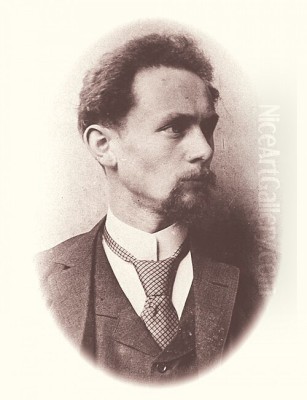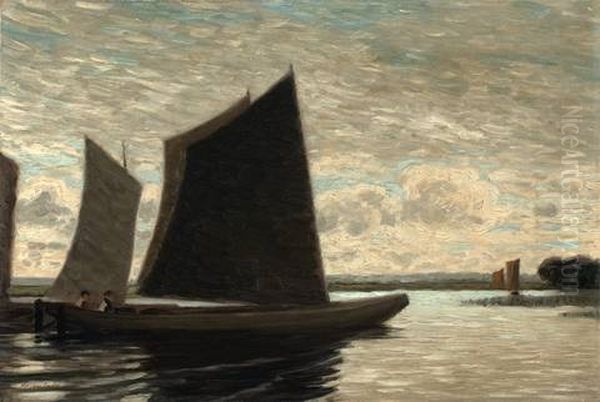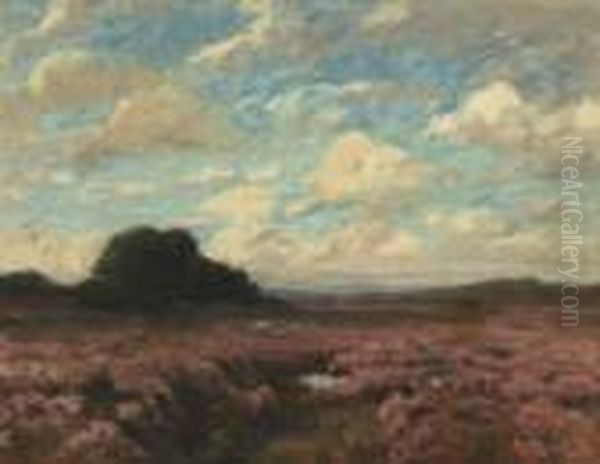
Hans am Ende (1864-1918) stands as a significant figure in German art at the turn of the 20th century, primarily celebrated for his evocative landscape paintings and his foundational role in the Worpswede artists' colony. A German national, his life and work are inextricably linked with the unique, atmospheric landscape of the Teufelsmoor (Devil's Moor) near Bremen, a region he helped transform into a vibrant hub of artistic innovation. His contributions extend beyond his own canvases, as he was instrumental in fostering a community that sought an authentic connection with nature, moving away from academic constraints towards a more personal and expressive art form.
The Allure of Worpswede and its Artistic Genesis
The late 19th century witnessed a burgeoning desire among many European artists to escape the confines of urban industrialization and the rigid doctrines of established art academies. This "back to nature" movement found fertile ground in various rural locales, with artists forming colonies to live and work in closer communion with the landscape and its people. Worpswede, a small village set amidst the expansive, often melancholic, peat bogs and heathlands of the Teufelsmoor in Lower Saxony, became one such haven.
The stark beauty of this region, with its wide skies, reflective waterways, birch trees, and thatched cottages, offered a profound contrast to city life. It was Fritz Mackensen who, in 1884, first recognized the artistic potential of Worpswede. He was soon followed by Otto Modersohn in 1889, and it was in this same year that Hans am Ende, captivated by the landscape and the burgeoning artistic spirit, also settled there. These artists, along with others who would soon join them, were drawn by the raw, unspoiled character of the moor, seeing in it a source of spiritual and artistic renewal.
Hans am Ende: A Founding Visionary

Hans am Ende was not merely a resident of Worpswede; he was one of its pioneering spirits. Alongside Fritz Mackensen and Otto Modersohn, he is considered one of the original founders of the Worpswede artists' colony. While the initial gatherings were informal, their shared vision and collaborative spirit led to the formal establishment of the "Künstlerverein Worpswede" (Worpswede Artists' Association) in 1894. This association, which later included figures like Carl Vinnen, aimed to promote their work and solidify their identity as a distinct artistic group.
Am Ende's commitment to the colony was profound. He, like his peers, sought to capture the unique light and atmosphere of the Teufelsmoor, developing a style that, while rooted in observation, was imbued with a lyrical and often introspective quality. His presence and dedication helped shape the colony's early ethos, emphasizing plein air painting and a deep, personal engagement with the subject matter.
Artistic Style: Capturing the Soul of the Moor
Hans am Ende's artistic style is characterized by its sensitive portrayal of the Worpswede landscape. He was a master of capturing the subtle nuances of light and atmosphere, often favoring the gentle, diffused light of dawn or dusk, or the quietude of a summer's day. His palette typically consisted of soft, harmonious tones, though he was also capable of employing more vibrant colors when the scene demanded, reflecting an influence from French Impressionism, particularly in the attention to outdoor light and its effects.
His brushwork was delicate yet expressive, conveying both the visual reality of the scene and the emotional response it evoked in him. There is a prevailing sense of tranquility and harmony in his paintings, a deep respect for the natural world, and an understanding of the symbiotic relationship between humans and their environment. While often categorized within the broader scope of German Impressionism or plein air painting, am Ende’s work possesses a distinct, almost poetic sensibility that aligns with the romantic spirit of the Worpswede group. His art was less about objective documentation and more about conveying the mood and essence of the landscape.
The influence of the Barbizon School, with its emphasis on realistic depictions of rural life and landscape, can also be discerned in the early Worpswede artists, including am Ende. However, they pushed beyond mere realism, infusing their work with a more personal, often melancholic or dreamlike quality that would later pave the way for some members of the group to explore Expressionistic tendencies.
Masterpieces of Moor and Meadow
Hans am Ende's oeuvre includes several works that have become iconic representations of the Worpswede landscape and his particular artistic vision.

Sommer im Moor (Summer Moor) is a quintessential example of his ability to capture the serene beauty of the Teufelsmoor. The painting likely depicts the expansive heath under a gentle summer sky, with characteristic birch trees and perhaps a reflective waterway. The soft light and harmonious colors would evoke a sense of peace and timelessness, inviting the viewer into the quietude of the moor.
Segelfahrt (Sailing Trip) showcases another facet of life in the region, where waterways like the Hamme River were vital. This work, often featuring traditional flat-bottomed peat barges or leisure sailboats, captures the interplay of light on water and the leisurely pace of life connected to these channels. The composition would emphasize the vastness of the sky and the reflective quality of the water, creating a harmonious balance. One version of Segelfahrt, measuring 70 x 106 cm, was notably offered at a VAN HAM Fine Art auction, highlighting its significance.
Quell im Herbst (Spring in Autumn, or Autumnal Spring) presents a scene imbued with the melancholic beauty of the changing seasons. The title itself suggests a poignant juxtaposition. The painting likely features a natural spring or water source amidst the rich, earthy tones of autumn foliage. Am Ende’s skill in rendering the soft, fading light of autumn and the reflective surfaces of water would be prominent, creating an atmosphere of quiet contemplation. A version of this work (73 x 60 cm) also appeared at VAN HAM.
Blühende Heide (Blooming Heath) captures the vibrant spectacle of the heathland in full bloom, typically in late summer when the heather transforms the landscape into a sea of purple and pink. This subject allowed am Ende to explore a richer, more colorful palette while still maintaining his characteristic sensitivity to atmospheric effects. The expanse of blooming heather under a wide sky would be a powerful motif. An example (75 x 100 cm) was also featured in auctions.
Torfboot vom Hammen (Peat Boat from the Hamme) is another work that speaks directly to the local culture and economy. Peat extraction was a traditional livelihood in the Teufelsmoor, and the distinctive peat barges were a common sight. This painting would likely depict such a vessel on the Hamme River, laden with its dark cargo, set against the backdrop of the moor. It’s a theme that connects the human element with the landscape, a recurring interest for Worpswede artists. A significant version (86 x 67 cm) was presented at a GRISEBACH Moderne auction.
These works, among others, not only showcase Hans am Ende's technical skill and artistic sensitivity but also serve as enduring documents of a unique landscape and the artistic community that it nurtured.
A Constellation of Contemporaries
Hans am Ende did not work in isolation. The Worpswede artists' colony was a vibrant community, and his interactions with fellow artists were crucial to its development and his own artistic journey.
The core founding members, Fritz Mackensen (1866-1953) and Otto Modersohn (1865-1943), were his closest early collaborators. Mackensen, often considered the "discoverer" of Worpswede for artistic purposes, was known for his genre scenes and portraits, often depicting the local peasant life with a sympathetic realism. Modersohn, who became one of the most celebrated Worpswede painters, developed a deeply personal and atmospheric style of landscape painting, often characterized by its melancholic beauty and rich, dark tones.
Carl Vinnen (1863-1922), a landscape painter from a wealthier background, joined the core group slightly later but became an integral part of the Künstlerverein Worpswede. His work often depicted the coastal and rural landscapes of Northern Germany with a robust, impressionistic touch.
Paula Modersohn-Becker (1876-1907), who married Otto Modersohn, arrived in Worpswede in 1898. Though her time there was relatively short, she became one of the most important early Expressionist artists in Germany. Her powerful, simplified forms and emotionally charged portraits of peasants, especially women and children, pushed the boundaries of the Worpswede aesthetic and gained her posthumous international acclaim. Her interactions with am Ende and others would have been part of the colony's dynamic artistic discourse.
Heinrich Vogeler (1872-1942) joined the Worpswede colony in 1894. Initially known for his elegant Art Nouveau (Jugendstil) etchings, illustrations, and paintings, Vogeler transformed his house, the Barkenhoff, into a central meeting place for the artists. His early work often featured romantic, fairy-tale-like scenes. Later, his art and life took a more politically radical turn.
Fritz Overbeck (1869-1909) was another key member of the first generation of Worpswede artists. He, too, was captivated by the moorland landscape, producing atmospheric paintings that captured its unique character. The Overbeck-Museum in Bremen, dedicated to his and his wife Hermine Overbeck-Rohte's work, also occasionally features exhibitions related to the broader Worpswede circle.
The user's provided text also mentions Otto Meisen and Otto von Lutzow as having co-founded an artists' colony in Worpswede with Hans am Ende in 1889. While Mackensen, Modersohn, and am Ende are more widely cited as the primary initiators of the colony that gained fame, Meisen and von Lutzow may have been part of these very early informal gatherings or a distinct, perhaps short-lived, initial grouping before the more formal association took shape. Their exact roles and artistic outputs would require more specialized research but point to the collaborative spirit present from the outset.
Beyond the immediate Worpswede circle, the artists were aware of broader European trends. The influence of French Barbizon painters like Jean-François Millet (1814-1875), known for his dignified portrayals of peasant life, and Théodore Rousseau (1812-1867), a master of atmospheric landscape, was significant for many artists seeking alternatives to academic art.
In Germany itself, figures like Max Liebermann (1847-1935), Lovis Corinth (1858-1925), and Max Slevogt (1868-1932) were pioneering German Impressionism. While their styles and urban connections often differed from the more rural and introspective focus of Worpswede, they shared an interest in capturing light, atmosphere, and contemporary life, contributing to the modernization of German art. The Worpswede artists, including am Ende, were part of this larger wave of artistic renewal.
The Enduring Legacy of Worpswede
The Worpswede artists' colony, with Hans am Ende as a key founder, quickly gained national and even international attention. Their group exhibition at the Munich Glaspalast in 1895 was a breakthrough, bringing their unique vision of the Teufelsmoor to a wider audience. While initially met with some criticism for its perceived somberness or provincialism, the authenticity and artistic quality of their work eventually won recognition.
The colony continued to evolve. While the first generation, including am Ende, largely focused on a lyrical, impressionistic interpretation of the landscape, later artists associated with Worpswede, most notably Paula Modersohn-Becker, embraced more avant-garde, Expressionistic styles. This evolution ensured Worpswede's continued relevance in the German art scene.
Hans am Ende's contribution was vital to this legacy. His dedication to capturing the specific character of the moor, his collaborative spirit, and his role in establishing the artists' association helped lay the groundwork for Worpswede's enduring success. The colony remains an active artistic center today, a testament to the vision of its founders.
Glimpses into the Artist's Persona: Anecdotes and Character
While detailed biographical accounts of Hans am Ende's personal life are not as widely circulated as those of some of his more famous contemporaries, the provided information offers intriguing glimpses into his character.
One anecdote suggests a period where "Hans's life underwent some peculiar changes, and he faced repercussions for mocking certain things, which troubled him." This hints at a possible irreverent or humorous side to his personality, perhaps a tendency to challenge conventions or speak his mind, which might have occasionally led to friction. It suggests a man not afraid of a little mischief, even if it brought discomfort.
Another piece of information reveals that in 1901, Hans am Ende wrote a letter to a doctor expressing his joy upon completing a painting and his hope that the artwork would "achieve its purpose." This speaks to a deep sense of commitment to his art and a belief in its potential to communicate or fulfill a meaningful role, perhaps to bring solace, beauty, or understanding to the viewer. It highlights his dedication and the personal investment he poured into his creations.
A particularly colorful insight comes from a text titled "A Cheerful Temperament," which describes Hans am Ende as having inherited his father's optimistic and humorous nature. Most strikingly, it mentions his habit of frequenting cemeteries and "recording his conversations with the deceased, and sometimes their conversations with him, in his diary." This extraordinary practice suggests a unique, perhaps macabre, sense of humor, a philosophical curiosity about life and death, and an unconventional way of processing the world around him. It paints a picture of an artist with a rich inner life and a distinctive, perhaps even eccentric, personality.
These fragments, though limited, suggest that Hans am Ende was more than just a painter of serene landscapes; he was a man of complex character, capable of humor, deep reflection, and perhaps a touch of the unconventional.
Exhibitions, Collections, and Lasting Recognition
Hans am Ende's works continue to be appreciated and sought after. His paintings have been featured in numerous auctions, attesting to their value in the art market. Prominent auction houses like VAN HAM Fine Art and GRISEBACH Moderne have handled sales of his significant pieces, including Segelfahrt, Quell im Herbst, Blühende Heide, and Torfboot vom Hammen. These works often originate from private collections, particularly within Germany, such as those in Baden-Württemberg, indicating a sustained interest among connoisseurs.
Beyond the auction circuit, am Ende's art has naturally been part of exhibitions focusing on the Worpswede artists' colony, both historically and in contemporary retrospectives. The Overbeck-Museum in Bremen, dedicated to fellow Worpswede artists Fritz and Hermine Overbeck, is one such institution that has likely showcased his work in the context of the colony's output. Museums in and around Worpswede, as well as larger German institutions holding collections of late 19th and early 20th-century art, would also be repositories or exhibitors of his paintings.
The fact that his works are primarily found in private collections and appear in specialized auctions speaks to a dedicated following. His legacy is preserved not only in these collections but also in the ongoing story of Worpswede itself, a place he helped put on the artistic map.
Conclusion: An Enduring Light on the Moor
Hans am Ende passed away in 1918, his life coinciding with a period of immense artistic and social change in Germany and Europe. The First World War, which concluded in the year of his death, irrevocably altered the cultural landscape. Yet, the art he created, and the artistic community he helped build, continue to resonate.
As a founding member of the Worpswede artists' colony, Hans am Ende played a crucial role in establishing a unique and influential movement in German art. His sensitive and lyrical landscape paintings captured the soul of the Teufelsmoor, offering a vision of nature that was both beautiful and deeply felt. His collaborations with contemporaries like Fritz Mackensen, Otto Modersohn, and later interactions with figures such as Paula Modersohn-Becker and Heinrich Vogeler, contributed to a vibrant artistic dialogue.
Though perhaps not as internationally renowned as some of his Worpswede peers, Hans am Ende's artistic achievements, his foundational work in the colony, and his intriguing personality secure his place as an important figure in German art history. His paintings remain a testament to the enduring power of landscape to inspire, and to the quiet beauty he found and so skillfully conveyed in the moors and meadows of Worpswede.